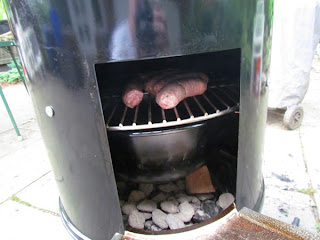In the meantime, we must cook and eat! And we will eat meat...smoked meat!
I'm still learning how to smoke beef brisket. Brisket was the first thing I made in the smoker, and this is go-round number two. This time I've decided to marinate it. The first brisket seemed a bit dry, so hopefully this may improve it.
I'm mixing up a marinade appropriately called "Marinade for Brisket of Beef," from one of Justin Wilson's cookbooks. I've used this on other cuts, namely roasts and thick steaks, and it's pretty good.
The basic ingredients are dry red wine, cooking oil, some onion powder, garlic powder, cayenne pepper, and red wine vinegar. Mix it up in de food processor or by hand.
Pour de marinate over the brisket. The brisket I have here is a bit on the small side - about 2 and a quarter pounds, but it will be good nonetheless.
Then we let the meat fais do-do in the marinade. (That is some Cajun French.).
I marinated this overnight - about 17 hours total.
Here we have our poitrine de boeuf after marinating. I'm using a cajun rub to season it.
Now we get the smoker ready. On the right is the bottom of the smoker - the pit that holds the coals. I have about 70 or so fresh coals in the bottom, and I just put about 30 or so lit ones on top.
On the left is the center section of the smoker that carries the water bowl and the two cooking grills.
And the lid is in the rear. You can see it's pretty easy to work with since it's in sections.
Not-so-great shot of the water bowl. I've got a couple of quarts of water in it. I've yet to have all the water evaporate out.
De boeuf on the top grill.
That brisket looks a little small on that grill...next time I go for Texas-size!
Last time I smoked, I had the wood chunks in the coals before I started. Of course, it started smoking right away, while I was still putting the meat on. That smoke is pretty acrid, and it's hard to work over it.
So this time I put a couple of small pieces of wood buried in the coals, and then tossed in a big hunk through the firebox door after it was all assembled. Worked out better for me.
This is hickory, by the way.
Bwahahahahahahaha!
The brisket will have to cook about 3 hours. After the first hour, I'm going to put these veal sausages on the lower grill. They should be done after 2 hours. This is my first foray into sausages on the smoker.
Notice these are "Italian Veal" sausages. This raises some questions in my mind. Were the calves actually Italian? And the package also says "Proudly made in the USA" but has an Italian flag over it. Did we merge with the Italians? (Not that there would be anything wrong with that...we would then be making Ferraris...).
I'm able to put the sausages on the lower grill via the smokebox door.
Now we just sit back, watch the temperature, and let it all cook for a couple more hours.
I kept the temperature between 225 and 235 degrees F for the whole time. However, I did discover that opening the smokebox door will make the temperature jump a lot - so I did see it go up to about 250 for a short time.
I probably could have just put the sausages on from the top. I needed to baste the meat every hour, and the first time was also when I put the sausage on. I just didn't want to have to take the top grill off.
I used a mixture of 75% apple juice and 25% oil for the baste. I put it in a sprayer and just squirted it on.
Lookit that. De sausages are done!
This is at the 3 hour mark for the beef - 2 hours for the sausage. I'm going to let the brisket stay on a bit longer. It's reading about 175 degrees and I'm shooting for 190.
But while the meat is still smoking, we can eat de sausages as a hoovy-doovy, yes?
Mmmmmmm sausage.
Sausages and mustard. The elixirs of life.
I'm already thinking next time I'll make a variety of sausage and have a German-style sausage fest.
Here's the brisket resting before I hack it up. The total cooking time was about 3 and a half hours.
I can smell it just looking at this picture! And it smells good! The combination of hickory smoke and cooked meat is mouth-watering.
Sliced and ready to eat.
Some notes: the marinade and rub combination were excellent. But the meat is still just a tad dry. I'm thinking the layer of fat on this piece was too thin - it was about an eight of an inch (maybe 3-4 mm) thick. It should be more like a quarter inch (6-8 mm). The fat melts and keeps the beef from drying out, and that may be the final piece of the puzzle.



















0 comments:
Post a Comment